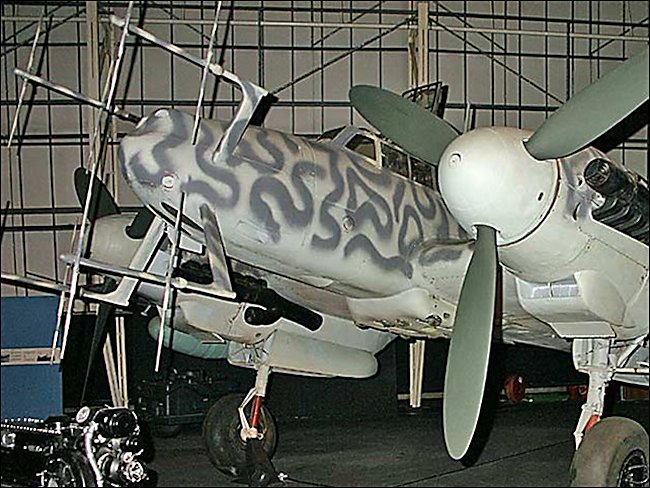Messerschmitt Bf110 light bomber
The Messerschmitt Bf 110 was designed in response to a 1934 specification for a long-range escort fighter and Zerstorer (destroyer) aircraft. It is often wrongly called the Me 110. Armament comprised four 7.9 mm (0.31 in) MG17 machine guns in the upper half of the nose and two 20 mm (0.79 in) MGFF cannon in a detachable tray attached to the fuselage belly. A manually operated MG15 machine gun was provided in the rear cockpit. It had a maximum speed of 348mph (560km/h) and a range of 1,500 miles (2,410 km). It had a ceiling height of 35,000 feet (10,500m). It had a crew of two but the night fighter variant had an additional crew member to operate the radar. First deliveries to squadrons were made in 1938.
In an air superiority situations that existed in the campaigns in Spain (1936 to 1939), Poland, Norway and the Low Countries, the Messerschmitt BF110s were effective long range fighter aircraft. With little aerial opposition it was able to attack targets with great accuracy.

Photograph taken at the RAF Museum, Hendon, London NW9 5LL England
The photograph above is of Messerschmitt Bf 110 G4 production serial number 730301. It was constructed in 1944. By the beginning of 1945 it was stationed at fighter base in Denmark, with the "Stammkennzeichen" I/NJG 3. Its roll was night defence of Denmark and Northern Germany against Allied bomber attacks. It was fitted with FuG 220b Lichtenstein SN-2 radar to help it find the RAF bombers in the night skies.
In mid 1940 being sent on missions as a day-fighter over the English Channel, Kent, Sussex, Surrey and London during the Battle of Britain, the Messerschmitt BF110 losses increased. The Bf 110 couldn't match the performance of the fast single engine RAF fighters such as the Spitfire or Hurricane. The Bf 110's lack of agility in the air was its primary weakness.
Despite suffering very serious losses during the Battle of Britain the aircraft continued in production. In 1940 the Messerschmitt factories turned out 1,008 Messerschmitt Bf 110 fighters and 75 Messerschmitt Bf 110 reconnaissance aircraft. During the Balkans Campaign, North African Campaign and on the Eastern Front, it rendered valuable ground support to the German Army as a potent fighter-bomber (Jagdbomber-Jabo).

Photograph taken at the RAF Museum, Hendon, London NW9 5LL England
The Messerschmitt Bf 110 C was also produced in fighter-bomber (C4, C7) and reconnaissance (C5) sub-variants.
The Messerschmitt Bf 110 D variant was originally intended as a long-range escort fighter, and the Bf 110 D0 pre-series aircraft featured a large ventral fuel tank, but the drag this created impaired the aircraft's performance to the extent that it was deleted in the production Bf 110 D1 and replaced by external wing tanks.
The Messerschmitt Bf 110 D2 variant could be used in either the fighter or bomber roles and could carry up to two 1000 kg (2205 1b) bombs, and the Bf110 D3 variant was a D1 with bomb racks attached.
The Messerschmitt Bf -110 E1 and E2 were designed as fighter-bombers and were able to carry four 50 kg (110 1b) bombs under the wing in addition to the larger bombs slung under the fuselage, while the E3 was a special long-range reconnaissance model.
The Messerschmitt Bf 110 F was similar to the E but with a strengthened airframe and upgraded armour. Designed either as a fighter-bomber (F1), a long-range fighter (F2) or a long-range reconnaissance (F3), it was the F4 that was specifically designed as a 3-crew night-fighter.
Earlier variants had 1300 hp DB 601 engines, but the final major production aircraft, the Messerschmitt Bf 110 G, produced in larger numbers than any other variant, adopted the 1350 hp DB 605 engine. Produced for all roles, but it was in the night-fighter role of the G2 but mainly the G4 that the Me 110 truly excelled and was responsible for the majority of Bomber Command's night losses due to fighter attack from early 1943. The top German night fighter ace, Major Heinz-Wolfgang Schnaufer, flew the Messerschmitt Bf 110 exclusively and claimed 121 victories in 164 combat missions.

Photograph taken at the RAF Museum, Hendon, London NW9 5LL England
Earlier variants had 1300 hp DB 601 engines, but the final major production aircraft, the Messerschmitt Bf 110 G, produced in larger numbers than any other variant, adopted the 1350 hp DB 605 engine. Produced for all roles, but it was in the night-fighter role of the G2 but mainly the G4 that the Me 110 truly excelled and was responsible for the majority of Bomber Command's night losses due to fighter attack from early 1943. The top German night fighter ace, Major Heinz-Wolfgang Schnaufer, flew the Messerschmitt Bf 110 exclusively and claimed 121 victories in 164 combat missions.
Fitted with additional fuel tanks for a longer endurance, many of the Messerschmitt Bf 110 G night-fighters were fitted with the "Schraege Musik", special machine guns firing at an angle of about 45' to a point above the fighter. This helped the crew to shoot down a bomber when flying parallel to it but underneath it.
A flame extinguisher, "Flammenvernichter" was also fitted instead of the normal exhaust system to help to subdue the blue exhaust flames so as to make it harder for enemy rear gunners to find their target.
Me 110 Books


Tweet